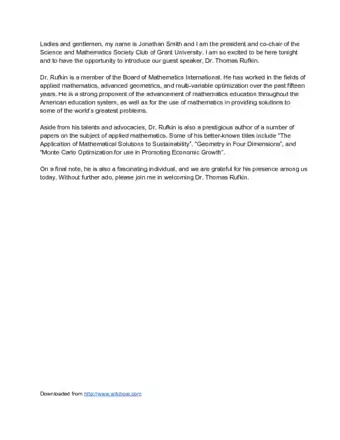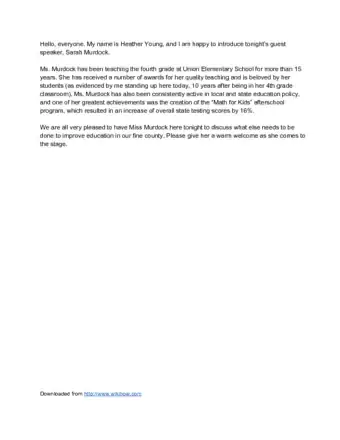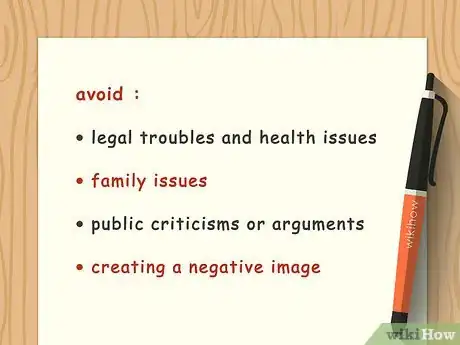This article was co-authored by Deb DiSandro. Deb DiSandro is the Owner of Speak Up On Purpose, an organization dedicated to improving and teaching public speaking. Deb has over 30 years of experience as a national speaker and has presented at the Erma Bombeck Writer’s Conference and the National Society of Newspaper Columnists. She was awarded the National Speakers Association Member of the Year 2007 and has been published in Writer's Digest, Daily Herald, Women's Day, and Better Homes & Gardens.
There are 7 references cited in this article, which can be found at the bottom of the page.
This article has been viewed 1,123,332 times.
Introductions can make or break a speech. Guest speakers depend on you to give them an enthusiastic welcome that prompts the audience to pay attention. A good introduction requires researching the speaker’s credentials. Write your speech to explain what the audience stands to gain from listening. By memorizing the introduction and giving it with enthusiasm, you can make any guest speaker sound amazing.
Steps
Sample Speeches
Researching the Speaker
-
1Ask the speaker what they’d like you to say. Many times, the speaker will have an introduction prepared for you. Even if they don’t, they can provide information you can use. When the guest speaker isn’t available, talk to people who know them, such as mutual acquaintances or their coworkers.[1]
- When the speaker provides an introduction for you, use it. Read it over a few times and be prepared to say it with energy and enthusiasm.
-
2Find out what subject the speaker will cover. Ask around to find out the focus of the speech. The speaker or the event organizers may be able to tell you. This way, you’ll be able to hone your speech so it introduces the speaker's topic. Your introduction needs to relay exactly what the audience can expect to hear.[2]
- For example, you find out the speech will be about encouraging young girls to learn computer programming. You shouldn’t spend time explaining how the speaker can teach these skills to adults.
Advertisement -
3Look up biographical information on the speaker. Search online for the speaker’s credentials. News articles, interviews, and websites associated with the speaker offer this information. Type their name into a search engine and pick out the details that relate to the speech. Often, you’ll find unique facts that fit into your introduction.[3]
- For instance, a professor’s biography on their school website might inform you that, “Jane Doe used her scientific research to identify ten new species of birds.” Try to find information relevant to the topic they will be speaking about.
- News articles and interviews will also have useful basic facts, such as “Jane Doe spent the last summer building schools in Africa.”
-
4Avoid using sensitive or embarrassing information without approval. Remember that your introduction is meant to promote the speaker. Issues like legal troubles, health issues, or family issues are complicated. They take up time and create a negative image. It’s not appropriate to bring up public criticisms or arguments others have made about the speaker. It’s also not a good idea to talk about their family.
- Always get the speaker’s permission before using these details. Make sure you can explain why it’s important to your introduction.
-
5Find other speeches the speaker has given. When you find a speech, pay close attention to the introduction. Search it for any details on the speaker you can use. Read the speech aloud and figure out what parts are well-written. Adapt these parts to improve your own introduction.[4]
- Don’t use your guest’s speech to write your introduction. They may be giving a different speech this time, so you’ll create false expectations in the audience.
- Be careful if you’re using pieces from another speech since it is copyrighted material and can’t be used without the speaker’s permission.
-
6Include a surprising detail if it fits in your intro. You may come across a detail that defines the speaker’s character but isn’t well known. The detail may also be something shared between you and the speaker. A good surprise detail does not detract from the focus of the speech. Many times, it can be used to get the audience to laugh or appreciate the speaker’s humanity.[5]
- For example, you met the speaker when working in a dog adoption center. Introduce this connection when beginning the speech. Finish by stating, “I know Jane Doe will inspire you to work better with your female students - and your dog.”
-
7Master pronouncing the speaker’s name. Make sure you find out the proper pronunciation. You may be able to find it online. If you can’t, contact the speaker, anyone they know, or the event planner. Improper pronunciation makes your introduction seem unprofessional. It is embarrassing and harms the credibility of both yourself and the speaker.[6]
-
8Check for any special titles the speaker has. Addressing the speaker by their proper title is professional and gives the speaker more credibility. Refer to a doctor as Dr. Jane Doe. Refer to a judge as Judge Jane Doe. The speaker may have titles you don’t recognize, such as Sir or Dame for someone knighted by the British monarch.[7]
- Again, the speaker can tell you how you should address them. This information may also be found online or gotten from other people.
Writing the Introduction
-
1Keep the introduction under three minutes long. Remember that you are there to introduce the guest speaker. Your introduction should not take over the event. A few short paragraphs is enough to set the stage. This is enough time to bring up the speaker’s credentials and capture the audience’s interest.[8]
-
2Explain the speaker’s qualifications. A goal of the introduction is to explain why the speaker was chosen to talk. Relevant credentials apply here. Highlight some of the speaker’s expertise in the subject matter. Examples of qualifications include published work, job experience, success stories. Show that the speaker is an authority, but keep the qualifications brief and relevant.[9]
- If the speaker is giving a talk about improving teamwork, for instance, mention that the speaker has changed the working environment in several Fortune 500 companies.
- You also wouldn’t want to list off degrees, awards, or Fortune 500 work experiences when the talk is about knitting at home.
-
3Tell the audience what they’ll learn by listening. It’s your job to capture the audience’s attention. To do this, express that the audience will get a lot out of the speech. The lessons should be relevant to the speaking event. If the speech is about public speaking, for instance, the audience wants to know what they can learn for their own lives.[10]
- For example, you might say, “John Smith will prove today that anyone can give a charismatic speech and that a little bit of anxiety isn’t always bad news.”
-
4Include a short personal anecdote if you have one. Chances are you were chosen to speak because you had some interaction with your guest. You don’t need to know the speaker well to do this. Since the speaker and their words appear personal to you, the audience will notice. They’ll relate to you and want to hear the speech.
- You can mention something like, “20 years ago I became acquainted with a man who has challenged me to be better. He has become a good friend.”
- You may also give a brief anecdote, such as “I heard John Smith speak in Miami and it moved me,” or, “Dr. Smith shared his ideas with me this morning and I guarantee you’ll love them.”
- Be careful not to gush since it could raise expectations for the speaker. It may reduce the speaker’s confidence if you brag too much.
-
5Avoid humor as much as possible. Humorous anecdotes take up time and are often embarrassing or unrelated to the speech. Sometimes they can work. You’ll have to use your judgment when employing humor. In some cases, such as after a sad or draining event, the audience needs a laugh.[11]
- For example, you can say, “John Smith inspired me to go out and build a cabinet. It fell apart in five minutes. But I listened to his speech again, and I learned so much that I was able to open my own cabinet business.”
-
6Introduce the speaker’s name at the end. The end line is considered the applause line. Have your speech build up to it. This is where the audience needs to show enthusiasm for the speaker. It is the only part of the speech where you need to state the speaker’s name and title.[12]
- For instance, you can say, “Please join me in welcoming Dr. John Smith!”
- You may also state the title of the speech if it is needed. This is helpful during large events when people are coming from various other locations or speakers.
- You could also introduce the speaker at the beginning of the speech and repeat their name throughout the introduction. This helps build familiarity with the audience.
-
7Read your speech aloud. Finish writing your speech, then read it back to yourself. Judge the way it sounds. The tone should be appropriate for the venue. Make changes, cutting out any unnecessary details or words that sound out of place. Also, try timing yourself. A good speech sounds smooth without dragging on.[13]
- Think of how you’d respond to the introduction if you were in the audience.
Giving the Speech
-
1Practice the introduction. A good introduction isn’t ad-libbed. Spend time rehearsing it before you’re set to go on. Having to rely on notes on stage is distracting to the audience. Instead, make sure you know the words and can say them effortlessly. Your introduction must sound fluent and energetic. You can practice your introduction numerous ways, such as by recording yourself or saying it in front of people you know.[14]
- When stage fright is a problem, try reciting the introduction while looking in a mirror. Once you feel comfortable, rehearse it in front of family and friends.
- Recording your introduction is a simple way of hearing yourself while you’re alone. Play it back and listen for any spots where you need to improve.
-
2Rehearse the introduction sparingly before going on stage. When you’re waiting for your moment, you’ll think to go over the introduction again. A few rehearsals is acceptable. Avoid wearing yourself out with numerous rehearsals and memorization. Let yourself feel secure from practicing and being enthusiastic about the guest speaker. It’ll keep your introduction from sounding scripted.
-
3Introduce yourself when you begin. Stating your name and title is useful if someone in the room is unfamiliar with you. Keep this line short so you can get to the rest of the introduction. Remember that you’re setting the stage for the guest speaker, so there’s no need for a long explanation of who you are. If someone introduced you earlier, you can skip this.
- Say, “Good evening. My name is Alex Brown and I’m the organizer of this event.”
- When everyone knows you, such as for a teacher introducing a speaker to a classroom, you don’t need to do this.
-
4Show enthusiasm while speaking. Because you practiced, you'll be ready to recite the introduction with enthusiasm. Keep the energy level high. Stand up straight. Increase the energy level as you build towards the introduction by producing a little more volume and authority. Remember how you’d want the introduction to sound if you were in the audience. You’d want it to inspire you to pay attention to the guest speaker.[15]
-
5Speak loudly and clearly. Many speakers get nervous or overexcited. They rush their speech, sounding inaudible. Slow yourself down. This ensures every part of your introduction is audible in the audience. You’ll notice that each word stands out and you can project to the back of the room.
-
6Lead the applause. When you get to the end, stand in place. State your final line with force. Be the first person to offer applause. As the introducer, you are setting the stage for the guest speaker. The audience will follow your lead, and nothing’s worse for the speaker than languid applause.[16]
-
7Orient yourself towards the speaker as they approach. Turn your body to them. Your feet should point at them and your eyes should meet theirs. Give the guest speaker a big, authentic smile. Stay in place and continue to applaud until they reach you.
-
8Shake the speaker’s hand. Shaking hands is a positive gesture. The audience will notice it. It’s a humanizing greeting that shows a bond between you and the speaker. Continue to face the speaker until they reach you on stage. Shake their hand and then walk confidently off stage.[17]
Community Q&A
-
QuestionHow do I introduce a guest speaker in a classroom?
 Deb DiSandroDeb DiSandro is the Owner of Speak Up On Purpose, an organization dedicated to improving and teaching public speaking. Deb has over 30 years of experience as a national speaker and has presented at the Erma Bombeck Writer’s Conference and the National Society of Newspaper Columnists. She was awarded the National Speakers Association Member of the Year 2007 and has been published in Writer's Digest, Daily Herald, Women's Day, and Better Homes & Gardens.
Deb DiSandroDeb DiSandro is the Owner of Speak Up On Purpose, an organization dedicated to improving and teaching public speaking. Deb has over 30 years of experience as a national speaker and has presented at the Erma Bombeck Writer’s Conference and the National Society of Newspaper Columnists. She was awarded the National Speakers Association Member of the Year 2007 and has been published in Writer's Digest, Daily Herald, Women's Day, and Better Homes & Gardens.
Owner, Speak Up On Purpose Use a phrase like, "We have a special guest today, who I am excited to introduce you to." Of course, this all depends on the age of the students.
Use a phrase like, "We have a special guest today, who I am excited to introduce you to." Of course, this all depends on the age of the students. -
QuestionHow do I introduce more than one guest speaker?
 Deb DiSandroDeb DiSandro is the Owner of Speak Up On Purpose, an organization dedicated to improving and teaching public speaking. Deb has over 30 years of experience as a national speaker and has presented at the Erma Bombeck Writer’s Conference and the National Society of Newspaper Columnists. She was awarded the National Speakers Association Member of the Year 2007 and has been published in Writer's Digest, Daily Herald, Women's Day, and Better Homes & Gardens.
Deb DiSandroDeb DiSandro is the Owner of Speak Up On Purpose, an organization dedicated to improving and teaching public speaking. Deb has over 30 years of experience as a national speaker and has presented at the Erma Bombeck Writer’s Conference and the National Society of Newspaper Columnists. She was awarded the National Speakers Association Member of the Year 2007 and has been published in Writer's Digest, Daily Herald, Women's Day, and Better Homes & Gardens.
Owner, Speak Up On Purpose Give each person the same amount of time in the introduction. But, don't make your introduction long-winded. Just say less about each speaker.
Give each person the same amount of time in the introduction. But, don't make your introduction long-winded. Just say less about each speaker. -
QuestionMy guest speaker keeps insisting on introducing himself when I have been very clear that this cannot happen. How can I persuade him?
 Deb DiSandroDeb DiSandro is the Owner of Speak Up On Purpose, an organization dedicated to improving and teaching public speaking. Deb has over 30 years of experience as a national speaker and has presented at the Erma Bombeck Writer’s Conference and the National Society of Newspaper Columnists. She was awarded the National Speakers Association Member of the Year 2007 and has been published in Writer's Digest, Daily Herald, Women's Day, and Better Homes & Gardens.
Deb DiSandroDeb DiSandro is the Owner of Speak Up On Purpose, an organization dedicated to improving and teaching public speaking. Deb has over 30 years of experience as a national speaker and has presented at the Erma Bombeck Writer’s Conference and the National Society of Newspaper Columnists. She was awarded the National Speakers Association Member of the Year 2007 and has been published in Writer's Digest, Daily Herald, Women's Day, and Better Homes & Gardens.
Owner, Speak Up On Purpose If your speaker is a seasoned professional, listen to his reasons. He knows what he is doing. If he is new to speaking, you can explain that your introduction is meant to set him up for success. Then ask him what you can add to the introduction that will support this goal.
If your speaker is a seasoned professional, listen to his reasons. He knows what he is doing. If he is new to speaking, you can explain that your introduction is meant to set him up for success. Then ask him what you can add to the introduction that will support this goal.
References
- ↑ https://www.sketchbubble.com/blog/introduce-guest-speaker-cover-bases-two-minutes-less/
- ↑ http://canuwrite.com/speech_introduce.php
- ↑ http://sixminutes.dlugan.com/how-to-introduce-a-speaker/
- ↑ http://canuwrite.com/speech_introduce.php
- ↑ http://www.write-out-loud.com/introduction-speech.html
- ↑ http://transitionus.org/sites/default/files/HowTo_IntroduceAGuestSpeaker_v1.0.pdf
- ↑ http://www.write-out-loud.com/introduction-speech.html
- ↑ http://transitionus.org/sites/default/files/HowTo_IntroduceAGuestSpeaker_v1.0.pdf
- ↑ http://sixminutes.dlugan.com/how-to-introduce-a-speaker/
- ↑ http://www.publicwords.com/2011/11/26/how-to-introduce-a-speaker-the-art-of-giving-and-receiving-a-great-introduction/
- ↑ http://sixminutes.dlugan.com/how-to-introduce-a-speaker/
- ↑ http://www.publicwords.com/2011/11/26/how-to-introduce-a-speaker-the-art-of-giving-and-receiving-a-great-introduction/
- ↑ http://www.write-out-loud.com/introduction-speech.html
- ↑ http://www.write-out-loud.com/introduction-speech.html
- ↑ https://www.llrx.com/1997/09/how-to-introduce-a-guest-speaker-tips-templates/
- ↑ http://sixminutes.dlugan.com/how-to-introduce-a-speaker/
- ↑ http://www.publicwords.com/2011/11/26/how-to-introduce-a-speaker-the-art-of-giving-and-receiving-a-great-introduction/
About This Article
Before introducing your guest speaker, introduce yourself in case there are people in the audience who don't know you. Then talk about the speaker’s background and qualifications, and give the audience a high-level overview of what they might learn from the presentation. See if you can include a short, personal anecdote about the speaker, like "I read their book and really loved it," for example. Try to keep your introduction to less than 3 minutes, and finish it by welcoming your speaker and telling the audience their name. For more advice on introducing a guest speaker, including how to research them in advance, keep reading!


















































































